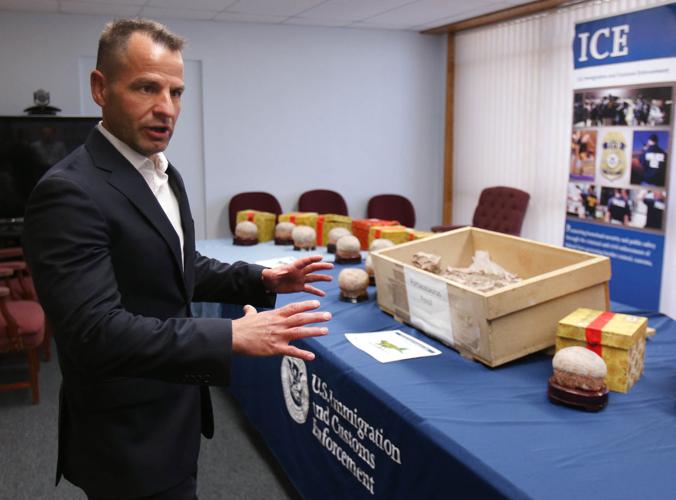An undercover operation at last year’s gem show led to the conviction of a Canadian man for smuggling dinosaur fossils from China.
Jun Yang, a 36-year-old resident of British Columbia, pleaded guilty to smuggling a psittacosaurus fossil and 16 hadrosaur egg fossils into the United States.
He was sentenced Monday in U.S. District Court in Tucson to five years’ probation and ordered to pay a $25,000 fine, the U.S. Attorney’s Office said.
The conviction stemmed from an undercover operation in February 2015 at the Globe-X Gem and Mineral Show at the Days Inn Hotel, 222 S. Freeway, court records show.
Homeland Security Investigations agents posed as shoppers while Yang, who was president of Arctic Products Inc., showed off his wares, court documents show.
Yang told the agents he was trying to sell the 100-million-year-old psittacosaurus fossil, which was dug up about 150 miles south of the border with Mongolia, for $15,000. The hadrosaur eggs, which Yang was trying to sell for $450 each, were found in central China.
Yang told the agents he removed the fossils from China and shipped them in containers along with stone carvings. He said he did not declare the fossils to customs agents.
The agents purchased the psittacosaurus fossil and hadrosaur eggs and sent photographs to an expert, who confirmed the type of fossil and their place of origin in China.
Agents reviewed the law of the People’s Republic of China and found the sale of special protected fossils to foreigners was prohibited, court records show.
The fossils were protected by cultural antiquities laws and therefore were illegal to import into the United States, said Chad Plantz, special agent in charge at Homeland Security Investigations.
Now that Yang has been sentenced, the fossils will be returned to the Chinese government, Plantz said.
In order to identify illegal fossils, agents go through rigorous training with the Smithsonian Institution, Plantz said.
“They have a pretty good idea by looking at the fossils and can determine where they’re from,” he said.
When an agent’s suspicion is aroused, photos are sent to experts to determine whether the fossils are protected under the Cultural Property Implementation Act, Plant said in reference to a U.S. law that came about after an international meeting to stop the black market trade of cultural antiquities.
“It’s a pretty large industry,” Plantz said of the illegal trade of fossils and other items.
Since the cultural antiquities program at Homeland Security began in 2007, the agency has seized more than 7,000 artifacts from 26 countries.
The artifacts include paintings from France, Poland, Germany and Austria, as well as Italian and Peruvian manuscripts dating from the 15th and 18th centuries.
The arrest of Yang was the first one dealing with fossils that Homeland Security agents have made at Tucson gem shows, Plantz said. The agency did not make any busts at the 2016 gem show.
But agents seized Burmese rubies at the 2015 gem show that were prohibited by the Office of Foreign Assets Control, a division of the U.S. Treasury that deals with economic and trade sanctions designed to further U.S. foreign policy goals.
The rubies were determined to be in the same class as conflict diamonds, the proceeds of which go to regimes that violate human rights or exploit child labor, Plantz said.
In general, the main sites of the gem show do not sell illegal items, but the same can’t be said about some of the smaller sellers on the outskirts of the show, he said.





